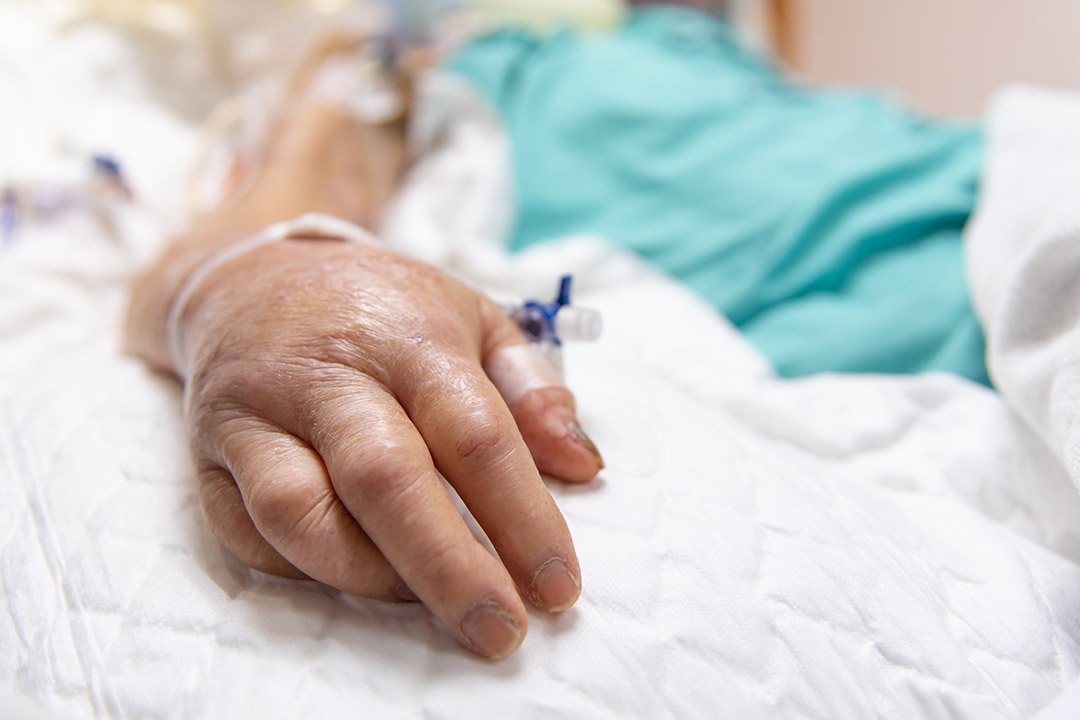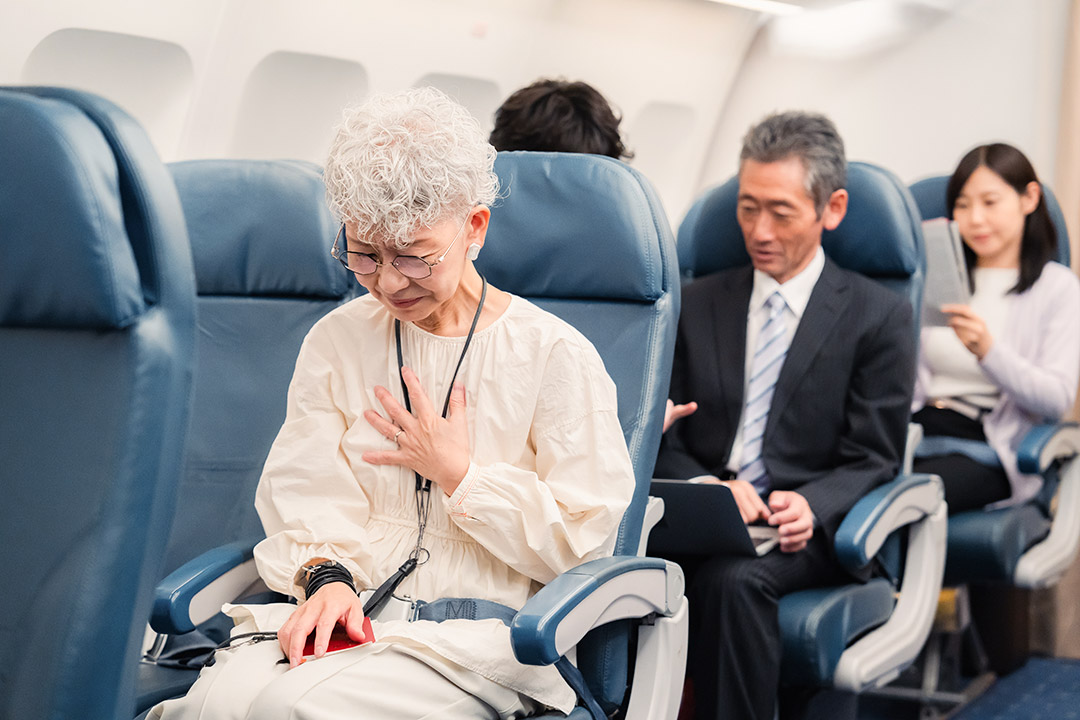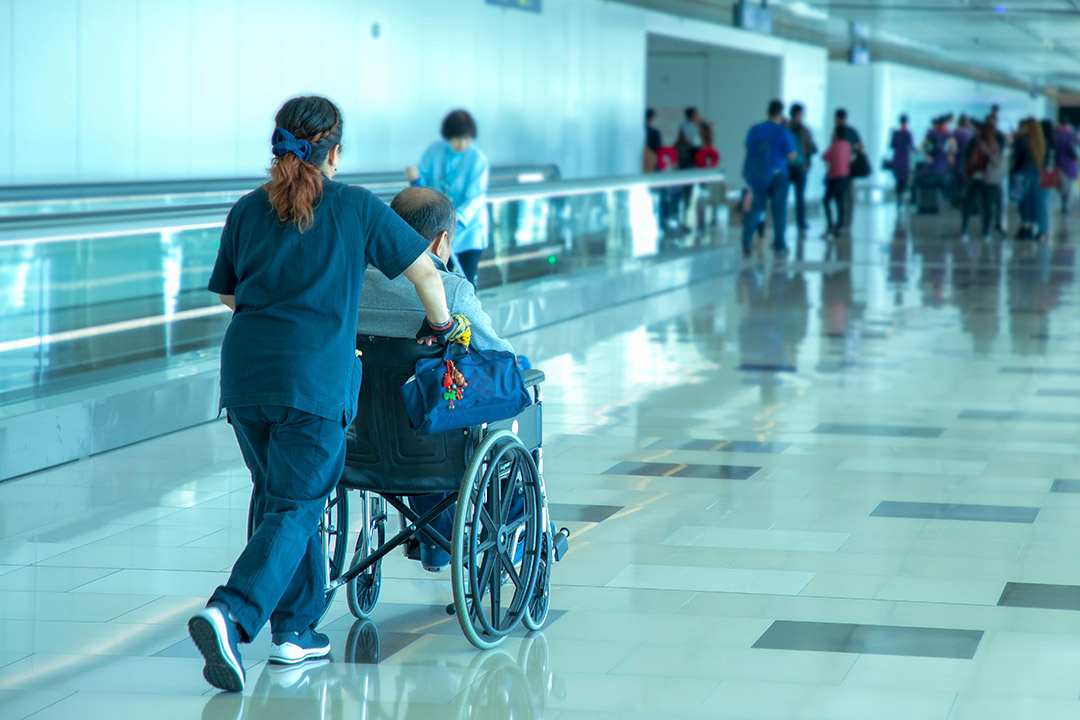Your doctor says your blood pressure is "under control," but as you pack for your trip, doubts creep in. Will the cabin pressure push your numbers into dangerous territory? Should you take your morning medication as usual, or maybe skip it and take two later? What if something goes wrong mid-flight? Most travelers with managed high blood pressure fly without incident, but learning your personal limits and the right precautions transforms uncertainty into confidence. MTI 24/7's aeromedical specialists reveal exactly what happens to your cardiovascular system during flight and when professional medical transport becomes necessary for your safety.
Can you fly safely with high blood pressure?
Flying affects your blood pressure through multiple mechanisms: reduced cabin pressure forces your heart to work harder, dry air causes dehydration that thickens your blood, travel stress releases hormones that constrict blood vessels, and prolonged sitting impairs circulation, all combining to elevate pressure readings even in well-controlled patients.
Blood pressure above 160/100 mmHg requires medical clearance before flying, while readings exceeding 180/110 mmHg pose serious risks including stroke, heart attack, and organ damage that become life-threatening when proper emergency care is hours away during commercial flights.
MTI 24/7 provides specialized transport solutions ranging from medical escorts who monitor patients on commercial flights to fully equipped air ambulances with sea-level cabin pressure and intensive care capabilities for those with severe or unstable hypertension.
Blood pressure and flying: What every traveler must know

High blood pressure, or hypertension, affects over 1.3 billion people worldwide and occurs when blood consistently pushes against artery walls with a force of 130/80 mmHg or higher, creating cardiovascular strain that becomes amplified during air travel.
Blood pressure classifications:
Normal: Below 120/80 mmHg.
Elevated: 120-129 systolic, below 80 diastolic.
Stage 1 hypertension: 130-139/80-89 mmHg.
Stage 2 hypertension: 140/90 mmHg or higher.
Hypertensive crisis: Above 180/120 mmHg (requires emergency care).
Blood pressure crosses into hypertensive territory when readings consistently measure 130/80 mmHg or above during multiple visits. However, single elevated readings do not confirm hypertension; your doctor needs multiple measurements over time to establish the diagnosis.
Symptoms of high blood pressure: Most patients with hypertension experience no symptoms, earning it the nickname "silent killer." However, severe cases may trigger headaches, shortness of breath, chest pain, dizziness, or nosebleeds. During a hypertensive crisis, symptoms escalate to severe headaches, blurred vision, confusion, nausea, or chest pain.
Risk factors that increase blood pressure: Age tops the list as arteries naturally stiffen over time. Excess weight forces your heart to pump harder through additional tissue. Smoking damages blood vessel walls, creating turbulence that raises pressure. Diabetes attacks small blood vessels throughout your body. Family history loads the genetic dice against you. Chronic stress, excessive sodium intake, alcohol abuse, and sedentary lifestyle compound these risks.
Treatment options: Modern hypertension management combines medications with lifestyle changes. ACE inhibitors and ARBs relax blood vessels. Beta-blockers slow heart rate and reduce cardiac workload. Calcium channel blockers prevent vessel constriction. Diuretics reduce fluid volume. Meanwhile, regular exercise, weight management, sodium restriction, and stress reduction provide natural blood pressure control.
Now that you know what constitutes normal versus dangerous blood pressure, the next question emerges: how does the aviation environment itself affect these carefully managed numbers?
Can flying affect blood pressure?
Flying creates a perfect storm of physiological stressors that can push your blood pressure beyond safe limits, even when your hypertension seems well-controlled on the ground.
Cabin pressure effects: Commercial aircraft maintain lower air pressure than ground level, reducing available oxygen. Your heart works harder and blood vessels constrict to compensate, naturally raising your blood pressure even if your medication keeps it stable on the ground.
Dehydration impact: Airplane cabins are extremely dry, quickly dehydrating your body and thickening your blood. Your heart must pump harder to move this concentrated blood through your arteries, creating additional pressure spikes that can persist throughout your flight.
Travel stress response: Flight anxiety, security lines, and travel delays trigger stress hormones that directly raise blood pressure. These chemical responses constrict your blood vessels while accelerating your heart rate, creating sustained pressure elevations during long flights.
Prolonged immobilization: Prolonged sitting compresses leg veins and prevents normal blood circulation. Your cardiovascular system compensates by working harder to pump blood back to your heart, increasing overall blood pressure throughout your journey.
Medication schedule disruption: Time zone changes disrupt your medication timing, creating gaps in blood pressure control. Missing doses or taking them at wrong times allows dangerous pressure spikes.
These combined factors explain why passengers with stable ground-level blood pressure can experience dangerous spikes during flight, making pre-travel medical consultation essential for anyone with cardiovascular concerns.
What blood pressure is too high for flying?

Most airlines do not enforce specific blood pressure limits, but medical experts establish clear safety thresholds that could save your life at altitude.
Safe flying thresholds: Blood pressure below 140/90 mmHg with stable medication generally allows safe commercial flying. Readings between 140-159/90-99 mmHg require medical clearance and careful monitoring. However, systolic pressure above 160 mmHg or diastolic above 100 mmHg significantly increases your risk of in-flight complications.
Dangerous pressure levels: Never fly with blood pressure exceeding 180/110 mmHg without medical supervision. This hypertensive crisis range puts you at risk of stroke, heart attack, or organ damage; emergencies that become life-threatening when you are hours from proper medical care.
Individual risk factors: Your personal flying threshold depends on more than numbers alone. Recent heart attacks, strokes, or uncontrolled diabetes lower your safe pressure limits. New medications, recent dosage changes, or symptoms like chest pain or severe headaches require medical evaluation regardless of your readings.
Medical clearance requirements: Pressure readings above 160/100 mmHg warrant physician consultation before booking flights. Your doctor may adjust medications, recommend delayed travel, or suggest medical escort services. Some severe cases require specialized medical transport rather than commercial aviation.
What are the risks of flying commercially with high blood pressure?
Commercial flights expose hypertensive passengers to serious cardiovascular complications that can escalate quickly without proper medical intervention available:
Stroke risk elevation: High blood pressure dramatically increases stroke risk during flight. Cabin pressure changes, dehydration, and immobility create the perfect conditions for blood clots to form and travel to your brain.
Heart attack potential: Hypertensive passengers face elevated heart attack risk as their overworked hearts struggle with reduced oxygen and increased stress. The combination of flight anxiety, dehydration, and medication disruption can trigger cardiac events in vulnerable travelers.
Organ damage acceleration: Sustained high pressure during long flights accelerates damage to kidneys, eyes, and brain. Hours of elevated readings can cause irreversible harm to these vital organs, particularly when combined with dehydration and reduced oxygen levels typical of commercial aviation.
Medication complications: Time zone disruptions compound medication timing errors, creating dangerous gaps in blood pressure control. Missing doses or taking medications at incorrect intervals can trigger rebound hypertension worse than your baseline readings.
These risks explain why travelers with uncontrolled hypertension should consider medical transport alternatives rather than gambling with commercial aviation safety.
How to fly safely with high blood pressure?

Smart preparation and strategic actions during flight can prevent dangerous blood pressure spikes and ensure your cardiovascular safety at altitude:
Pre-flight medical preparation: Schedule a doctor's appointment at least two weeks before departure to review your current medications and blood pressure control. Bring recent readings and discuss your travel itinerary, including flight duration and destination time zones. Your physician may adjust dosages, prescribe additional medications, or recommend delaying travel if your pressure is not adequately controlled.
Medication management strategy: Create a detailed medication schedule adjusted for your destination time zone before departure. Pack all blood pressure medications in your carry-on bag with extra doses for potential delays. Set multiple phone alarms to maintain consistent dosing intervals during travel. Never skip doses, even if you feel fine; flight stress can trigger sudden spikes hours later.
Proper hydration: Drink water consistently throughout your flight, aiming for small sips every fifteen minutes rather than large amounts infrequently. Avoid alcohol and excessive caffeine, which can worsen dehydration and interfere with blood pressure medications. Pack an empty water bottle to fill after security and request frequent refills during long flights.
Movement and positioning: Walk the aisle every hour during long flights to prevent blood pooling and circulation problems. Perform seated exercises like ankle circles, calf raises, and leg extensions when walking is not possible. Choose aisle seats when booking to facilitate movement without disturbing other passengers.
Stress reduction techniques: Practice deep breathing exercises during takeoff, turbulence, and landing when flight anxiety peaks. Download meditation apps or calming music before your trip. Arrive at the airport early to avoid rushing and the stress of potential delays. Consider mild anti-anxiety medication if prescribed by your doctor for severe flight anxiety.
Dietary considerations: Avoid high-sodium airplane meals and airport foods that can spike blood pressure within hours. Pack low-sodium snacks like unsalted nuts, fresh fruit, or whole grain crackers. Request special meals when booking if you have strict dietary restrictions for blood pressure management.
Sleep and fatigue management: Adjust your sleep schedule gradually before traveling across multiple time zones to minimize medication timing disruptions. Consider upgrading to premium economy or business class for better rest on long flights, as sleep deprivation can significantly elevate blood pressure.
Blood pressure monitoring equipment: Pack a portable digital blood pressure monitor in your carry-on to track readings during travel. Choose a validated, cuff-style monitor rather than wrist devices, which prove less accurate during flight conditions. Take baseline readings before departure and monitor periodically during long flights, especially if you experience symptoms like headaches or dizziness. Document any concerning readings to share with medical professionals if needed.
Emergency preparedness: Carry a written list of your medications, allergies, and emergency contacts in your wallet. Wear medical identification jewelry indicating your hypertension and key medications. Know the symptoms of hypertensive crisis and inform flight attendants immediately if you experience severe headaches, chest pain, or vision changes.
MTI 24/7 recommends these strategies based on thousands of successful patient transports, but travelers with poorly controlled hypertension should consider medical escort services rather than attempting commercial flights alone.
MTI 24/7 services for patients with high blood pressure

When your doctor recommends against commercial flying due to your blood pressure, or when you are simply too worried to travel alone, MTI 24/7 understands your concerns and provides safe alternatives that let you reach your destination with peace of mind.
Commercial Medical Escort Services
Imagine having a skilled nurse or paramedic sitting right beside you on your flight, someone who understands your condition and knows exactly what to do if your blood pressure spikes. That is what an air medical escort provides, transforming a frightening journey into a manageable experience. You will travel on the same commercial flight you originally planned, but with professional medical support every step of the way.
When this service is right for you
If your blood pressure readings hover around 140-159/90-99 mmHg, or if you have recently started new medications and feel uncertain about flying alone, a medical escort gives you the confidence to travel. This service is perfect when you are managing your hypertension well but worry about "what if" scenarios during flight. Maybe you need to visit family for an emergency, attend an important business meeting, or reach a medical specialist; situations where you can't simply cancel your trip because of blood pressure concerns.
How we care for you
Your medical escort will introduce themselves before boarding and explain exactly how they will monitor your condition throughout the flight. They will check your blood pressure regularly but discreetly, ensuring your privacy while keeping you safe. If you start feeling anxious or notice symptoms like headaches, they are available to assess your condition and take appropriate action. They will remind you when to take your medications, help you stay properly hydrated, and encourage movement to maintain good circulation. Most importantly, they provide the reassurance that comes from knowing a medical professional is watching over you.
Private Air Ambulance Solutions
When commercial flying is not safe for your condition, an air ambulance becomes your lifeline to essential travel. Picture a flying hospital room designed specifically for your needs, where the cabin pressure remains at comfortable ground level and medical equipment surrounds you for instant use. You'll have a dedicated medical team whose sole focus is keeping you stable and comfortable throughout your journey.
When this service becomes necessary
If your blood pressure consistently reads above 180/110 mmHg, or if you have recently experienced a hypertensive crisis, commercial aviation simply is not worth the risk to your health. This service becomes essential when you are taking IV blood pressure medications, recovering from a stroke or heart attack, or dealing with kidney complications from severe hypertension. Sometimes urgent medical treatment at a distant facility requires this level of transport; you cannot wait for your condition to stabilize when time-sensitive care is needed.
How we ensure your safety
From the moment our team arrives to collect you, you will feel the difference specialized care makes. The aircraft cabin maintains the same comfortable pressure as ground level, eliminating the cardiovascular stress that makes you feel worse on commercial flights. A critical care physician or nurse monitors your blood pressure continuously using advanced equipment that provides instant, precise readings. If your pressure spikes, they can immediately administer IV medications to bring it under control. You will rest comfortably while sophisticated monitoring systems track every aspect of your cardiovascular function, ensuring early detection of any changes in your condition.
Whether you choose medical escort services or air ambulance transport, MTI 24/7 handles every detail so you can focus on your health and peace of mind. We coordinate with your personal physician, arrange ground transportation, and ensure receiving hospitals are prepared for your arrival. You are never just a patient to us; you are someone who deserves to reach your destination safely, whether that is for life-saving treatment, precious family time, or essential personal matters.
Your high blood pressure does not have to ground your important travel plans when professional medical transport makes the journey both possible and safe.
Contact us to fly safely with high blood pressure!

You deserve to reach your loved ones and important destinations safely, regardless of your blood pressure concerns. Contact MTI 24/7; our caring medical team understands your worries and will create a personalized travel solution that protects your health every step of the way.
Reach us by:
Phone: USA: +1 646 335 06 83 / UK: +44 20 3608 0959
Email: info@mti-247.com
Our contact form
:quality(75))
:quality(75))